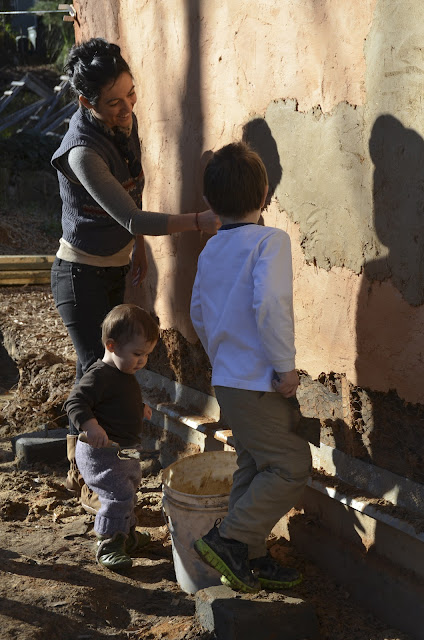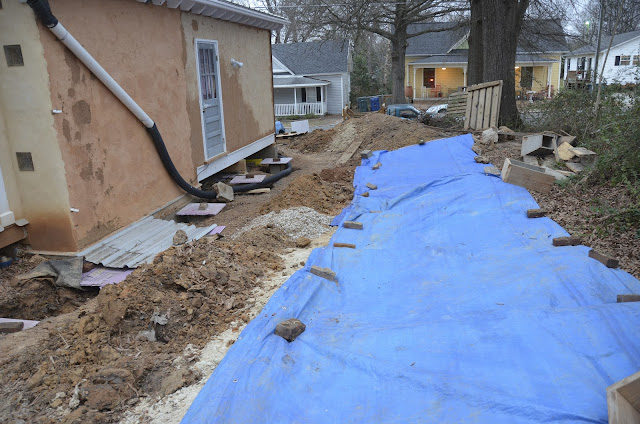Most every building project begins with digging down into the earth. Here's a footing form for one of the foundation piers.
All the concrete for the current build as well as the previous addition was hand-mixed. There are certainly advantages to having a concrete truck deliver the material for a big pour: it saves your body; there's no powdery concrete dust in the air, and you can easily order different types of mixes with different additives.
However, I've decided that I want to make more of an effort to use as little concrete as possible, since it has such a high embodied-energy. This is why I've been utilizing pier foundations more, instead of continuous foundation walls. I definitely don't miss the stressful nature of a concrete delivery. Once the truck is there, everything is a mad rush! If the forms fail, it's a nightmare. I used to get pretty frustrated during big pours. Wheelbarrow mixing is quieter and more pleasant.
(Using actual stone is ideal, of course, but not always an option)
It's fun to think of ways to use extra concrete at the end of a pour. Here's my latest simple idea, below. Once it cures, pull away the orange bricks and you're left with concrete bricks! (which I can anticipate using in the future, for various things)
The clay soil is beautiful to dig through. On this site, it transitions from topsoil, to bright red clay, to a tannish clay, and then to white, powdery clay. And there is often an interesting purple sedimentary layer above the white clay that is just 1/8" thick or so (which you can't see in the photo).
We try to keep our different dirt in separate piles, in the hopes of using some of it to make earthen plasters.
The pile of white clay looked so enticing to my plaster eyes that I had to try it out last weekend. I just added water and chopped straw (because it seemed to already have quite a bit of sand), and then I troweled it onto the wall, with the help of Danielle, little Leo, and Ian.
The footings are all poured here, and I have just begun to start filling the pier forms with concrete, after making sure that they were all lined up and level to each other.
It's been rather rainy lately, so water management around the concrete has taken some effort (not to mention keeping the concrete warm enough during the cold nights). Notice the ad-hoc gutter extension.
The foundation work all went really well. Simple and smooth. Here are the finished piers and stemwall. It has it's own kind of beauty to me. Forming stone into the a desired shape is an empowering thing. It's sad to consider how much of our earth we have covered in tar and concrete, and I'm glad that the concrete footprint for this addition is relatively small (just a line and a couple dots, from a birds-eye view).
It's sometimes difficult to appreciate the clay soil when it's wet and sticking to your boots all day and weighing down your feet. If able to put this inconvenience aside, it's gorgeous! When it gets wet and the colors are saturated, you can see so many different hues. Yellows, reds, blues, purples, whites...
TEAMWORK! (below)
You can tell Mike and I have been working together for a long time.
framing the first wall:
raising part two of the east wall:
It's really exciting to get the walls up, and then cut out the window openings and start to understand what the space will really be like (computer modeling can only take you so far).
Even Leo can peek out the bedroom window.
He also enjoys walking between the floor joists.

If you're wondering why the roof pitch is so low, it's because we're going to install a living roof. Plants will be growing up there! So shedding water is not as big of an issue as keeping the plants from falling off.
I like the following photo because it exemplifies how the house has been built in stages. The orange plaster on the left is from part one, and the tan and brown plasters are from the latest addition. The door is just temporary, but will be knocked out into a wide, arched doorway eventually. The exterior light fixture was just installed to pass the electrical inspection, but was never even used, and will be removed soon. Someday soon these exterior walls will be interior walls. The metal exhaust vent that you see at the top left is coming from the bathroom. It will have to be extended through the new roof another 14 feet. Everything is changing and growing. It's a fun way to build a house. The design for parts 2 and 3 have been altered dramatically after completing and living in part 1. I think the overall design has benefited significantly from building in phases (despite the small annoyances that have been required to pass building inspections between each phase).
It is obvious that Leo enjoys being on the worksite (and outside, in general).
His mother's arm is never far away, especially around power tools (as shown here).
This is Danielle telling him that it's time to leave and go home, and him trying to wrench away with all his muscle, and stay put.
So far we've been working for maybe 2 weeks, and all the rafters are up. Over the next week we will get the decking on the roof, the floor figured out, and the walls closed in more fully. Hopefully it will be wired soon, and windows installed before my parents leave to go back to New York by the end of the month...































